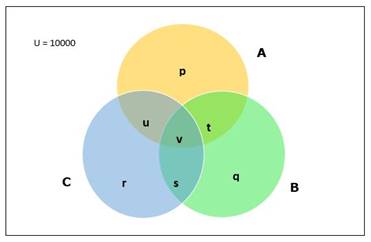In a town of 10,000 families, it was found that 40% of the families buy newspaper A, 20% buy newspaper B, 10% buy newspaper C, 5% buy A and B; 3% buy B and C, and 4% buy A and C. IF 2% buy all the three newspapers, find the number of families which buy
(i) A only,
(ii) B only,
(iii) none of A, B, and C.
Given:
Total number of families = 10000
Percentage of families that buy newspaper A = 40
Percentage of families that buy newspaper B = 20
Percentage of families that buy newspaper C = 10
Percentage of families that buy newspaper A and B = 5
Percentage of families that buy newspaper B and C = 3
Percentage of families that buy newspaper A and C = 4
Percentage of families that buy all three newspapers = 2
To find:
(i) Number of families that buy newspaper A only
Consider the Venn Diagram below:

Number of families that buy newspaper A = n(A) = 40% of 10000
= 4000
Number of families that buy newspaper B = n(B) = 20% of 10000
= 2000
Number of families that buy newspaper C = n(C) = 10% of 10000
= 1000
Number of families that buy newspaper A and B = n(A ∩ B)
= 5% of 10000
= 500
Number of families that buy newspaper B and C = n(B ∩ C)
= 3% of 10000
= 300
Number of families that buy newspaper A and C = n(A ∩ C)
= 4% of 10000
= 400
Number of families that buys all three newspapers = n(A ∩ B ∩ C)=v
= 2% of 10000
= 200
We have,
n(A ∩ B) = v + t
500 = 200 + t
t = 500 – 200 = 300
n(B ∩ C) = v + s
300 = 200 + s
s = 300 – 200 = 100
n(A ∩ C) = v + u
400 = 200 + u
u = 400 – 200 = 200
p = Number of families that buy newspaper A only
We have,
A = p + t + v + u
4000 = p + 300 + 200 + 200
p = 4000 – 700
p = 3300
Therefore,
Number of families that buy newspaper A only = 3300
(ii) Number of families that buy newspaper B only
q = Number of families that buy newspaper B only
B = q + s + v + t
2000 = q + 100 + 200 + 300
q = 2000 – 600 =1400
Therefore,
Number of families that buy newspaper B only = 1400
(iii) Number of families that buys none of the newspaper
Number of families that buy none of the newspaper =
10000 – {n(A) + n(B) + n(C) – n(A ∩ B) – n(B ∩ C) – n(A ∩ C) + n(A ∩ B ∩ C)}
= 10000 – (4000 + 2000 + 1000 – 500 – 300 – 400 + 200)
= 10000 – 6000
= 4000
Therefore,
Number of families that buy none of the newspaper = 4000